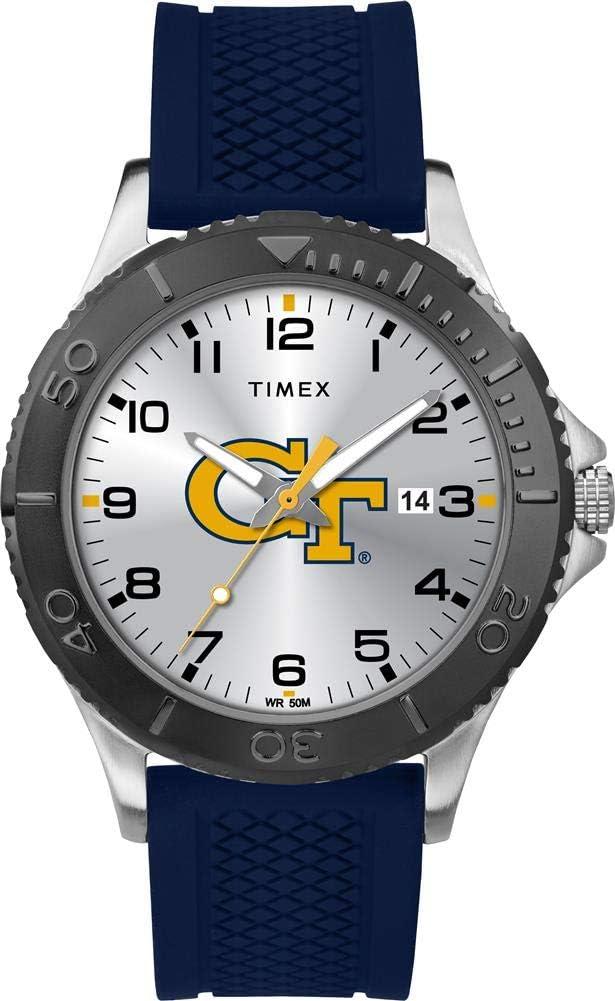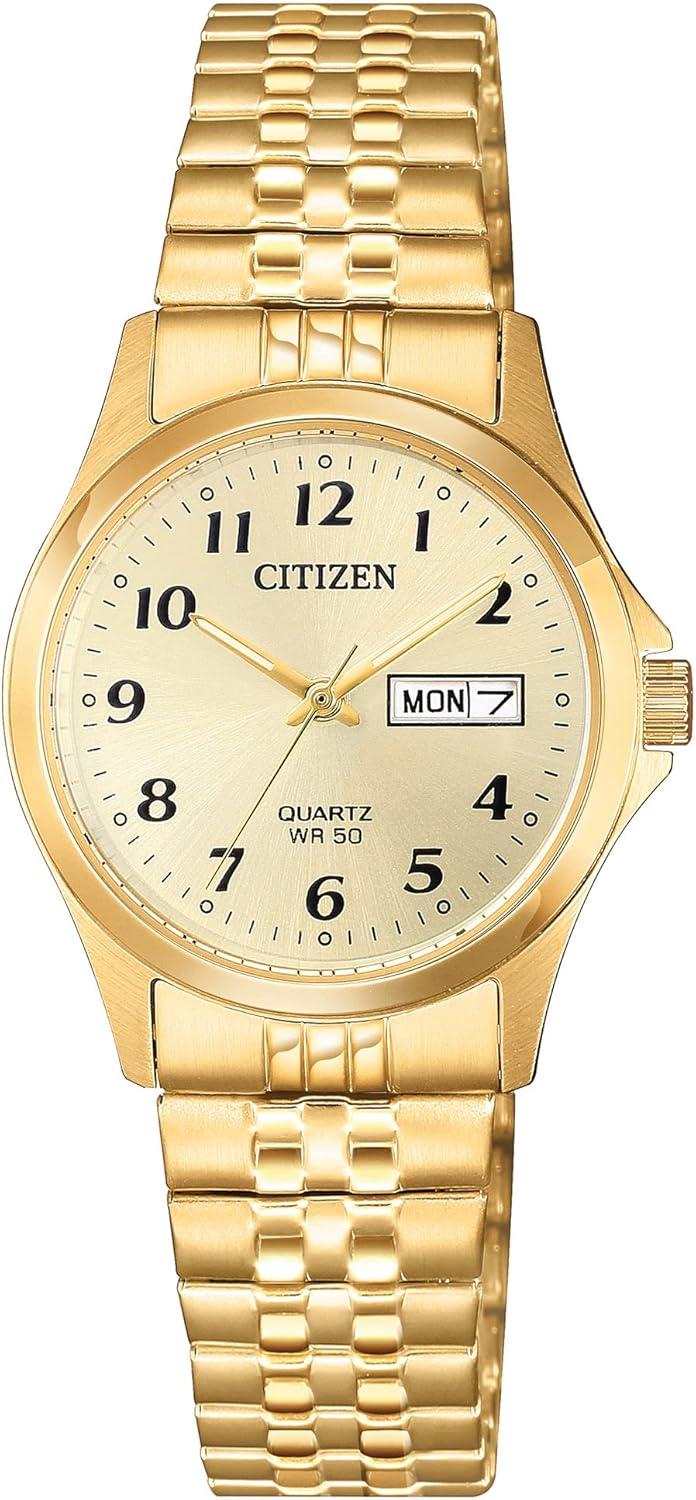
Bell & Ross BR-03 GMT Compass Review: An Aviation-Inspired GMT That Balances Theater and Tool
The Bell & Ross BR-03 GMT Compass is one of those rare modern releases that can be explained in a single sentence - “a GMT watch that looks like a cockpit compass” - yet rewards a long look. It belongs to the brand’s Flight Instrument family, where each model borrows the visual language of a specific aircraft gauge and translates it into something you can actually wear. For 2025, the BR-03 GMT Compass arrives as a 500-piece limited edition priced at $5,000, and it aims to thread a difficult needle: keep the drama of an aviation instrument while delivering a GMT that’s genuinely usable, legible, and comfortable day to day.
This in-depth review goes beyond the press notes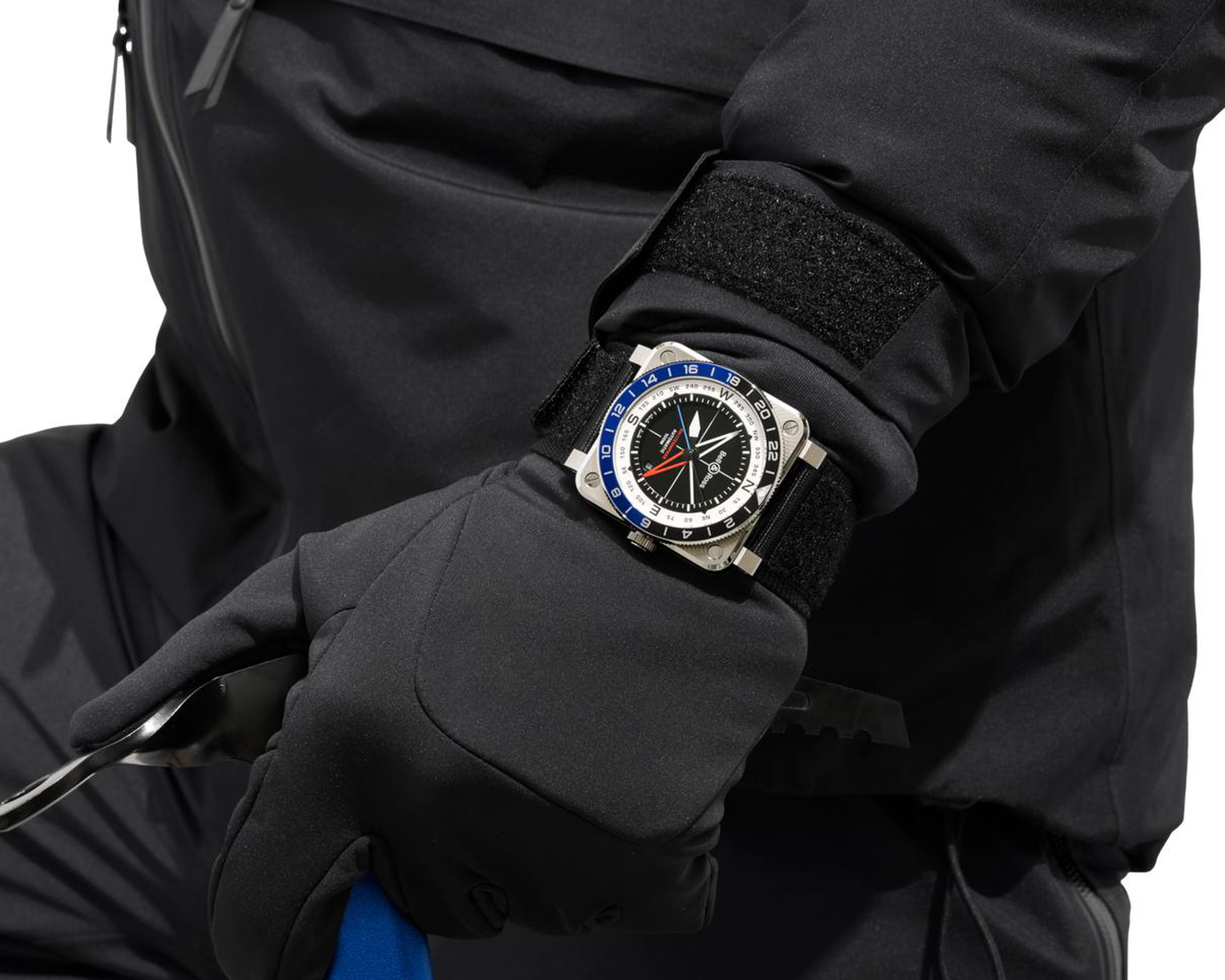
. We’ll unpack why the design choices matter, how the “caller”-style GMT behaves in real life, whether the solar-compass idea is more than marketing, and where this watch sits alongside stalwarts like the Rolex GMT-Master II, Tudor Black Bay GMT, Longines Spirit Zulu Time, Sinn’s no-nonsense UTCs, and budget-savvy SW330 competitors.
Why This Watch Exists: The Flight Instrument Playbook
Bell & Ross earned its reputation by leaning hard into cockpit aesthetics - big, square cases that echo panel-mounted gauges, screws you can see, typography that looks printed by a maintenance manual. 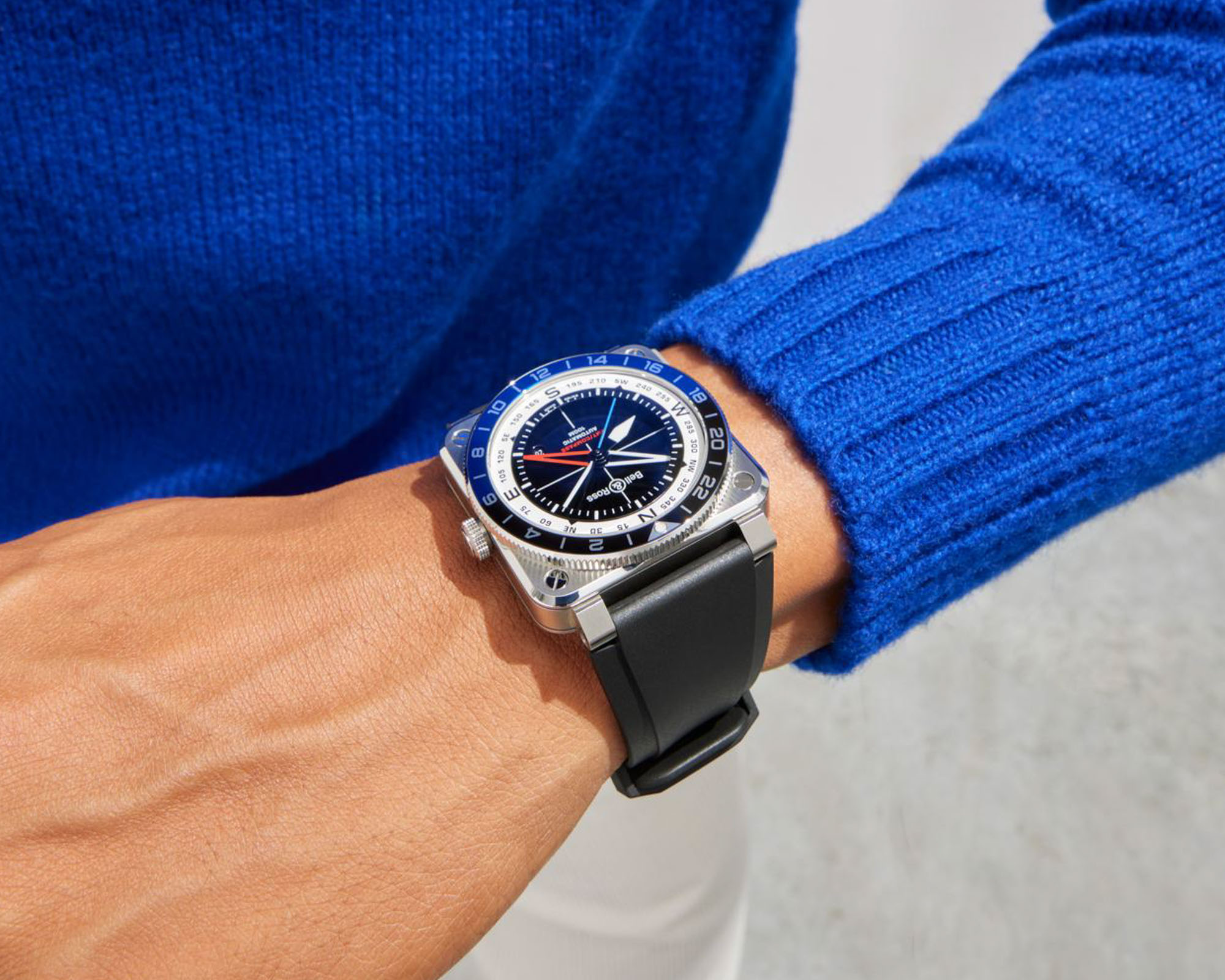
In the Flight Instrument series the concept becomes literal: HUD-like overlays, horizon lines, gyrocompass graphics. The BR-03 GMT Compass continues that narrative but dials back the extremity just enough to fit more wrists. Instead of neon graphics or opaque dials, you get classic steel finishing, a functional rotating 24-hour bezel, and a dial that reads as a compass without sacrificing clarity.
Case, Finishing, and Everyday Wearability
The square stainless-steel case measures 42 mm across and 12.3 mm thick. Those numbers suggest presence, but the short, integrated lugs, broad flat crystal, and alternating brushed-and-polished planes keep the watch stable and visually slim. At 100 meters of water resistance and with a flat sapphire crystal, it’s built for real use - from a rainy commute to poolside travel days. Bell & Ross opts for screw bars instead of spring bars; you’ll spend an extra minute swapping straps, but you gain reassuring robustness when your wrist clips a door frame.
Two straps ship in the box: a black rubber strap with a signed tang buckle for heat, water, and airports, and a black fabric hook-and-loop strap for micro-adjust comfort and that “flight jacket” vibe. Practically, this pair lets the watch swing from office to field without pretending to be a dress piece; it keeps its tool-watch identity in both modes.
24-Hour Bezel: Day/Night Readability Done Right
Surrounding the crystal is a bidirectional rotating bezel with a 24-hour scale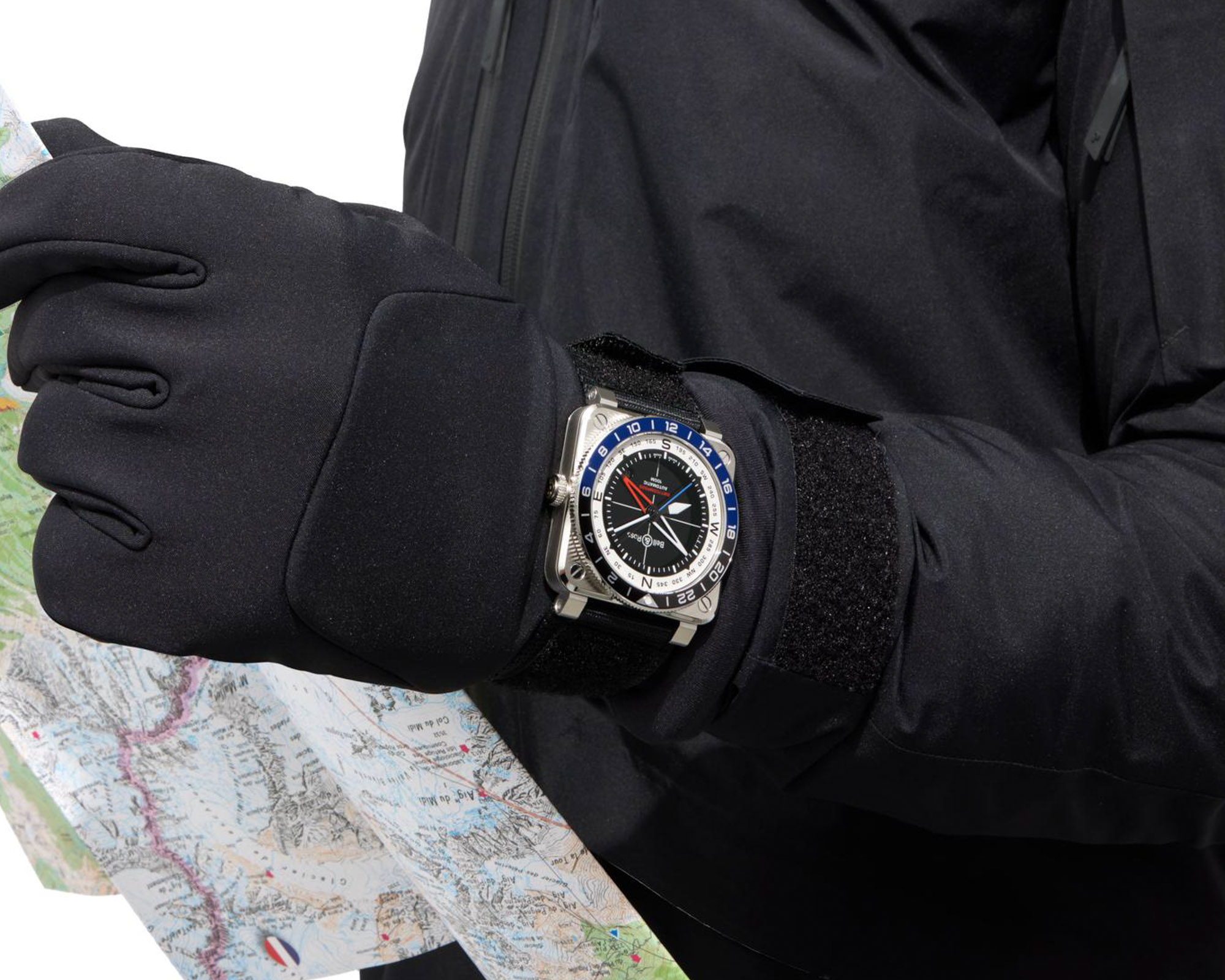
. The anodized aluminum insert is split into black and blue halves - instantly legible day/night separation that GMT fans will associate with famous “Batman” palettes. The point isn’t mimicry; it’s ergonomics. 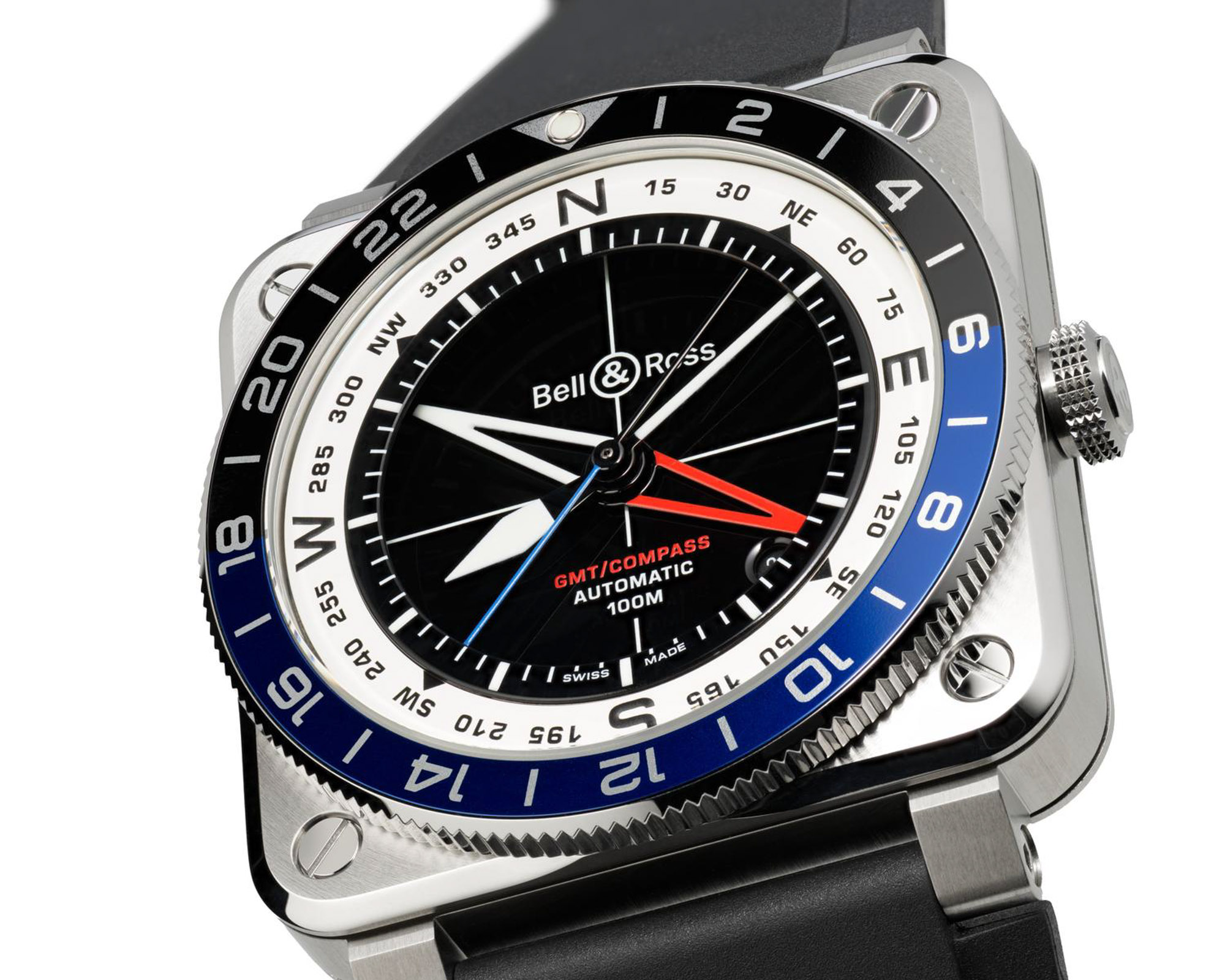
When you glance at the red-tipped GMT shape against the bezel, the color break halves your cognitive load and speeds the read. For third-time-zone juggling, the clean numerals and friction are tuned to quick, confident clicks rather than ornamental resistance.
Dial Language: Crosshairs, a Diamond GMT Hand, and a 360° Flange
Where the watch plants its flag is the dial. A matte black surface is bisected by a thin crosshair - pure instrument panel. The hour and minute hands are restrained; the 24-hour hand is an elongated, double-sided diamond with one half in vivid red for immediate pick-up. A blue seconds hand ties into the bezel’s night sector
. The date is a small, round aperture at about 4:30 - there when you need it, unintrusive when you don’t.
Encircling the dial is a bold black-and-white chapter ring (flange) printed with a full 360-degree compass scale. It’s the theatrical flourish that sells the “compass in a case” idea. Crucially, the flange appears to be fixed, not a rotatable inner ring. That decision preserves the clean look but shapes what the scale can do: it’s a reference index rather than a live calculator.
Movement Deep Dive: BR-CAL.303 (Sellita SW330) and the Caller vs. Flyer Question
Inside ticks the BR-CAL.303 automatic, Bell & Ross’s implementation of the Sellita SW330 architecture. 
Specs land where you expect: 28,800 vph (4 Hz) and roughly 56 hours of power reserve. More important than the numbers is the GMT behavior. This is a caller-style GMT: you can set the 24-hour hand and the date independently, but the local 12-hour hand does not jump in one-hour increments. For travelers who hop time zones weekly, a flyer-style GMT (jumping local hour, date linked forward/back) remains the gold standard at border control. For professionals who mostly stay put and monitor a second zone - New York HQ while you’re in London, home while you’re on a short-haul assignment - the caller layout is perfectly logical, and often cheaper, slimmer, and easier to service.
In practice, the BR-03 GMT Compass excels at “stay-put + track remote” duty and still handles occasional travel with a minute’s crown work. The bezel gives you a temporary third zone, and the red diamond makes quick work of AM/PM ambiguity.
Solar Compass: What Works and What Doesn’t
Can you actually navigate with it? You can use any 24-hour-hand watch as a simple solar compass if you know the drill. Set both local time and the 24-hour hand correctly. Keep the watch level. In the Northern Hemisphere, rotate the watch until the hour hand points at the Sun; the 24-hour hand will point north. In the Southern Hemisphere, align the 12 o’clock marker with the Sun; the 24-hour hand points south. On the BR-03, the double-sided diamond and high-contrast scale make the orientation easy to see.
Where the BR-03 differs from dedicated field watches is the fixed 360° flange. Because you can’t rotate that scale to match your reading, it acts as a static protractor rather than an interactive tool. A pragmatic workaround some owners use with caller-GMTs: temporarily move the 24-hour hand to align with a desired bearing, estimate against the flange, then return it to reference time. It’s not expedition-grade wayfinding, but it’s better than guesswork and preserves the compass aesthetic without over-promising.
On the Wrist: Ergonomics of a Square Tool Watch
Square cases can wear larger than their round counterparts, but the BR-03 mitigates that with a wide, flat caseback that spreads load and low-slung lugs that don’t overhang. The visual footprint is assertive but not cartoonish. The crown clears the wrist neatly, and the rubber strap’s pliability counters the geometry. In short: the watch looks like an instrument and wears like a modern sports GMT, which is precisely the point.
Where It Sits in the GMT Landscape
Versus Rolex GMT-Master II “Batman”
The Rolex remains the flyer-GMT benchmark with near-surgical usability and ceramic bezel durability. It’s also far pricier at retail (and stratospheric on secondary). The Bell & Ross costs less, is limited, and leans hard into cockpit theater. If you value the instrument narrative and prefer a square case, the BR-03 scratches an itch Rolex doesn’t.
Versus Tudor Black Bay GMT and Longines Spirit Zulu Time
Tudor brings flyer-GMT function and a heritage-diver aesthetic; Longines offers excellent finishing and classic pilot styling. Both sit below the B&R’s price in many regions and feel like traditional round watches. The BR-03 offers a wholly different wearing experience - square, graphic, and purposefully “panel-mounted.”
Versus Sinn UTC and Other SW330 “Value” GMTs
German tool specialists like Sinn emphasize anti-magnetism, tegimented steel, and ruthless legibility. SW330-based options from microbrands and value-focused makers provide the same underlying mechanics for less. What they typically don’t deliver is the distinct Flight Instrument identity - a cohesive story executed with this much visual intent.
Who It’s For
- Design-driven enthusiasts who want their GMT to look like a cockpit instrument but function like a daily watch.
- Professionals tracking a second time zone more often than they cross borders.
- Collectors who appreciate limited runs and a clear design brief, not just specs.
Key Specs (At a Glance)
- Reference: BR0393-COM-ST/SRB
- Case: 42 mm x 12.3 mm, stainless steel, brushed/polished
- Crystal: Flat sapphire
- Water resistance: 100 m
- Bezel: Bidirectional, 24-hour, black/blue anodized aluminum insert
- Dial: Matte black with crosshair; fixed 360° compass flange
- Hands: Red-accent diamond 24-hour hand; blue seconds
- Date: Circular window near 4:30
- Movement: BR-CAL.303 (Sellita SW330 architecture), 28,800 vph, ~56 h power reserve, caller-style GMT
- Straps: Black rubber; black fabric hook-and-loop
- Edition/Price: Limited to 500; $5,000 USD
What We Learned After Extended Wear
Two weeks of alternating straps and mixed desk-to-weekend use surfaced clear themes. First, the bezel’s day/night split tangibly speeds reads when you’re tired, jet-lagged, or glancing between calendar calls. Second, the fixed flange is mostly an aesthetic win with occasional utility for rough bearings - expect that, and you won’t be disappointed. Third, the caller layout is fine for single-trip travel; it’s only on multi-city hops that the flyer advantage shows decisively. Finally, the case finishing deserves praise: brushed planes take scuffs gracefully, and polished highlights keep the square from feeling blocky.
Value, Price, and the “Wearability” Debate
At $5,000 the BR-03 GMT Compass sits above many SW330 peers and below ceramic-bezel flyers from the usual suspects. What you pay for is not raw spec inflation but identity. “Wearability” shouldn’t be a headline achievement, but within Bell & Ross’s instrument experiments it matters: some Flight Instrument pieces are breathtaking one-watch shows; this one wants to be your daily. If your priority is maximum function per dollar, you’ll find alternatives. If you want a distinctive narrative executed as a competent GMT, the price aligns with the experience.
FAQs: Bell & Ross BR-03 GMT Compass
Is the BR-03 GMT Compass a true navigator’s compass?
No. It can be used as a simple solar compass thanks to the 24-hour hand, but the fixed 360° flange is a reference scale, not a rotatable bearing tool.
What’s the difference between caller and flyer GMT?
Caller (BR-CAL.303 here): set the 24-hour hand independently; local hour does not jump. Flyer: jump the local hour forward/back in one-hour steps while the 24-hour hand stays on home time - faster at passport control.
How many straps are included?
Two: black rubber with tang buckle and black fabric hook-and-loop. Both attach with screw bars for extra security.
Is the bezel ceramic?
No. It’s an anodized aluminum insert in black/blue. Aluminum keeps weight and cost down and fits the tool aesthetic, though it’s more prone to marks than ceramic.
Will the square case feel too large?
It wears smaller than the 42 mm spec implies due to short lugs and a flat caseback. Try the fabric strap for maximum comfort if you’re on the fence.
Key Takeaways
- An aviation-inspired GMT that looks like a cockpit compass but acts like a real daily watch.
- Caller-style SW330 architecture excels at tracking a second zone; still fine for occasional travel.
- Fixed 360° flange = strong visuals and rough-bearing utility, not a full navigation tool.
- At $5,000, you’re buying design identity and limited production as much as specifications.
- Two straps and 100 m water resistance make it easy to live with in the real world.
Bottom Line
The Bell & Ross BR-03 GMT Compass succeeds by refusing to choose between story and substance. It embraces the romance of the cockpit without turning into costume jewelry, and it delivers the practical core of any GMT - clear dual-time reading - in a package that’s distinct in today’s sea of round travel watches. If you want a flyer GMT with ceramic everything, look elsewhere. If you want a square, steel, aviation-literate GMT that you’ll actually wear, this limited edition lands exactly on heading.


